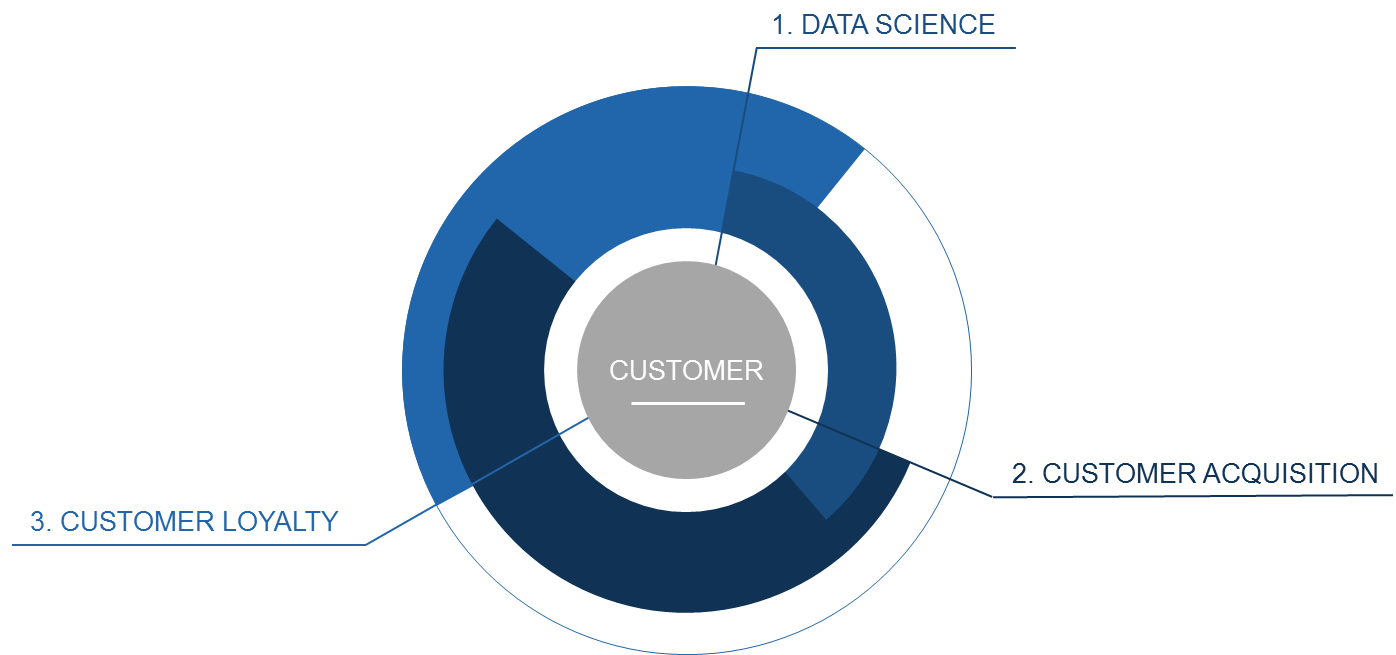From Big to Smart – Using Big Data in Customer Acquisition

Christian Lämmerer
Managing Director
Styria Marketing Services
1. Who is Styria Marketing Services
Styria Marketing Services (hereinafter referred to as SMS) is part of Styria Media Group AG and as internal service provider responsible for personal contact with customers such as readers, (digital) users and subscribers. Styria’s top brands like “Kleine Zeitung”, “Die Presse”, “Wienerin”, “miss”, “Diva”, “Sportsmagazin” and “Top-Times” (hereinafter referred to as brands) trust in the services of SMS. We cluster them in three main domains:

2. Define the Problem
Although a lot of media companies were already facing digitalization for quite some time, with daily newspapers leading the way, the area of customer acquisition was often left out from the digital transformation. SMS addressed this neglect. In order to establish data-driven marketing for Styria, we built a data unit around our CRM system as central data pool and established Big-Data practices in customer acquisition.
In the years prior to this project, the 2013 implemented CRM system has already been successfully in use as central data tool and provided a platform for user, readers and subscribers related activities for Styria’s brands.
The next consequent step was the question how to further use the gathered data and in what ways marketing benefits from (Big-) Data. Since we think the right answer to this question is to make the right data available for use, SMS started a profound program for change to improve customer acquisition using data-driven marketing services. The following four main goals were defined:
- Identify each touchpoint a customer has with one of Styria’s brands through collecting data in a comprehensive way
- Pool and utilize the gathered information in a central system (i.e. the central B2C-CRM run by SMS)
- Establishing a base for data-driven marketing services and make these services available to Styria’s brands
- Introduce data-science to the company in order to further professionalize marketing and to establish data-science as new domain of SMS’ business activities
Further goals were the reduction of scattering losses through a shift in our customer acquisition activities, from a broad target-group based approach to a “Single View of Customer” and to enable key user of our brands to perform professional data-driven marketing campaigns.
3. Planning and rollout

To ensure agile tasks handling and flexible coordination between teams working on the project in different paces, the project was separated into the following steps:
- Analysis & Strategy (Q4/2014)
A companywide location of the various different data pools, sources and touchpoints between customers and our brands and further categorization in regards to size, complexity, structure and rhythm of dataflow. - Creating a central database and implement Big Data (Q1/2015 – ongoing)
Each data source was addressed and interfaces between these sources, the brand’s touchpoints and the CRM were established. Excluded data silos were integrated and dataflow was centralized. - From Big Data to Smart Data (Q1/2015 – ongoing)
Through our ever growing database the need of simplifying collected information arose. During the process we call “Smart Data” our data scientist cluster and refines relevant information through implementing algorithms and using scoring and profiling in order to make the data tangible for targeted use. Further, SMS’ experts support Styria’s brands in selecting and applying data in marketing activities. - Single View of Customer (Q3/2017 – ongoing)
With the usage of AI, a Recommendation Engine was developed. It combines various sources of data throughout the company and supports our brands and shops through displaying (real-time) content based on a customer’s preferences.More generally, the development of this engine can be considered the cornerstone for the continuous ongoing progress into the direction of a “Single View of Customer”. Through creating intelligent data pools, which are able to handle both structured and unstructured data, and the growing usage of AI (in combination with human employees) we want to further push data-science in customer acquisition to gain an individual understanding of each of our users.
4. Resources
The project was realized mainly with resources from within the SMS, however for some sub projects, we consulted internal and external partners. Within SMS additional employees were hired, for the projects implementation as well as in the data-science unit.
- The newly formed Big-Data-Unit “X-Data” was responsible for the coordination of the project’s steps 2 to 4. The unit offers data-driven services for Styria’s brands (as described in Section 5. Project’s progress).
- Additional employees for data-science were hired. Their task is it to refine and simplify the data as well as the development of the customer scoring as a feature for our marketers.
Technology wise resources:
- SAP: The CRM as central data base is an SAP System, the algorithms implemented by our data scientist are written within this system.
- SPSS: In order to identify potential new customers, based on their interaction with Styria’s services, we developed an individual scoring using SPSS. This enables us to act out specific customer acquisition activities based how likely one will become a customer. This scoring is currently used in customer service too (i.e. how likely will a customer terminate his subscription).
- Recommendation Engine: In cooperation with “Styria Media Service Croatia”, we developed an engine that derives personalized recommendations for one of our brands’ online-shop customers. Using data such as past purchases, preferences in products derived from clicks in prior newsletters and online-shop visits as well as cross-sectional socio-demographic information, single-customer fitted newsletters are generated automatically. The therefor implemented algorithms apply collaborative filtering as well as matrix factorization as tools to merge and analyze the given data.
- Data Lake: Currently we are in the midst of creating a data lake in order to kick-start our next development stage, which is to be able to link different kind of data sources and to support our single customer’s whole journey even more.
5. Project’s Progress and Success?
As a consequence of our efforts, we are now able to offer entirely new services for Styria’s brands such as data-science in general, data-driven marketing campaigns, customer scorings etc. These services allow their users to perform more target-group specific campaigns up to single customers focused activities, which consequently improved customer acquisition since their start as well as customer retention. Further, the structured handling and analysis of our vast amount of data enabled us to spot potential for up- and cross selling for our brand’s products.
Through not limiting these new services solely to internal brands but offering them also to Styria-external customers, we were able generate an additional 6-figure revenue stream in 2017. Following, some more examples for our projects progress and success are given:
- After 2 years of service, more than 150 to 200 data-driven marketing campaigns p.a. were already performed
- Customer retention activities are up to 27% more successful thanks to precise selection based on data
- Through new data-driven services, CRM’s use grew by approx. 30% p.a.
- Since the start our project in 2014, we successfully supported our two main brand to hold paid circulation on a constant level
- Acquisition scores proofed their value as conversion rates were significantly higher than in the test-groups. (i.e.: campaigns to reactivate inactive customers performed 8% basis points better than those without scoring).
6. Challenges
- User Integration: “Data-driven marketing means cultural change”. One of the biggest challenges throughout the project was not to overwhelm users with the newly implemented digital services and to avoid the users’ rejection, caused by breaking old habits. Services needed to be understandable and released in smaller cluster easier to handle. Users were offered trainings and support to familiarize them with the application. Furthermore, consequent management on all levels and constant open and honest communication through all steps of the project was required to face this challenge.
- GDPR: As a consequence of the recently adopted General Data Protection Regulation, we aligned our Big-Data-Affords with the new legal environment. Since we are held to check legal conformity of our data-driven practices on a regular basis, this will be an ongoing challenge in the future, which has and will require adjustments to meet given regulations.
7. Future goals and long-term issues
Based on our CRM system and data-science efforts, first AI-applications (e.g. recommendation engine) are in use. Our future objective is it to further develop our data-science unit and to increase AI’s use, not only in customer acquisition and marketing activities but also in other business areas of SMS and its brands. Artificial Intelligence will be applied to determine our users’ individual decision making reasons and to derive personalized offer and services from it.
Naturally, the expansion of our data pools and improved utilizations of data are requirements for future development. There is an increased importance of handling not only structured but also unstructured data in order to harness the rapidly growing sources of information. Especially the integration of (written) customer feedback and its analysis will play a crucial role in our long-term Big-Data strategy.
Currently we are working towards the objective of optimizing our brands’ digital value chain. This involves accompanying and guiding users from “unknown” through various stages up to “digital subscriber”, with the aid of different data-driven tools and (self-) services. Generally, our data-driven activities long term effort is it to establish a profound bond between users and Styria’s brands.
Additionally, the further technological and digital training and support of the project’s stakeholders (i.e. key users, employees, brand units etc.) is an important factor for future development.
